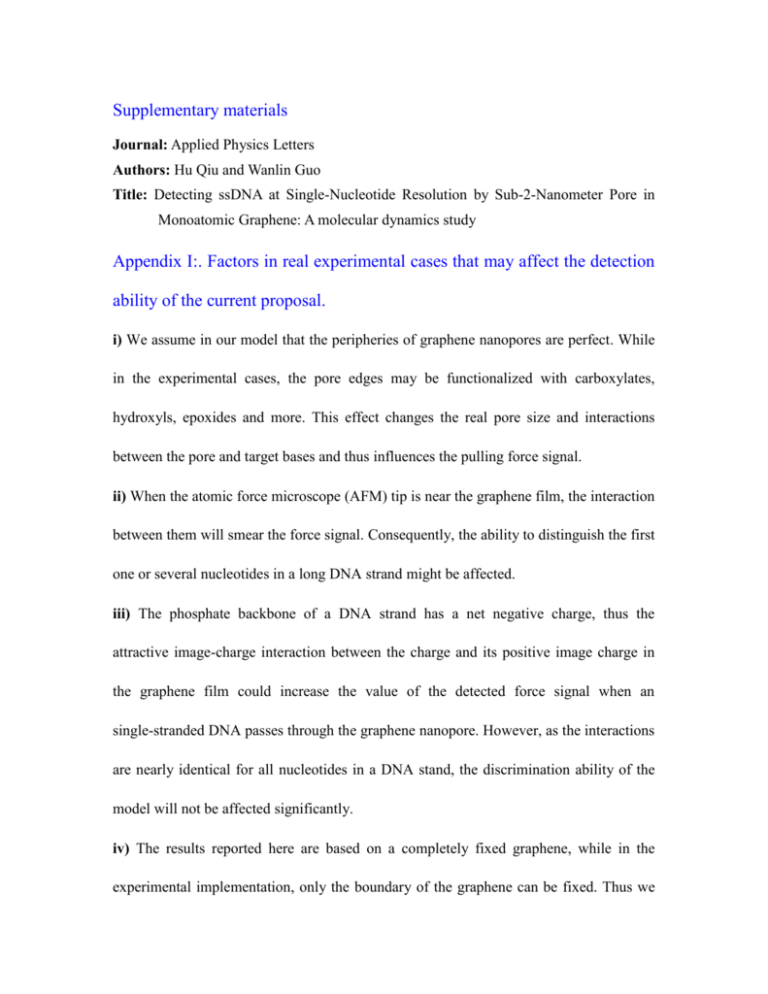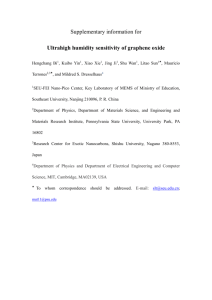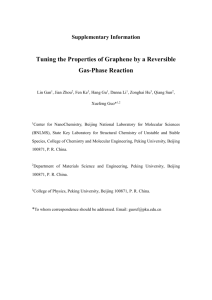Supplementary materials
advertisement

Supplementary materials Journal: Applied Physics Letters Authors: Hu Qiu and Wanlin Guo Title: Detecting ssDNA at Single-Nucleotide Resolution by Sub-2-Nanometer Pore in Monoatomic Graphene: A molecular dynamics study Appendix I:. Factors in real experimental cases that may affect the detection ability of the current proposal. i) We assume in our model that the peripheries of graphene nanopores are perfect. While in the experimental cases, the pore edges may be functionalized with carboxylates, hydroxyls, epoxides and more. This effect changes the real pore size and interactions between the pore and target bases and thus influences the pulling force signal. ii) When the atomic force microscope (AFM) tip is near the graphene film, the interaction between them will smear the force signal. Consequently, the ability to distinguish the first one or several nucleotides in a long DNA strand might be affected. iii) The phosphate backbone of a DNA strand has a net negative charge, thus the attractive image-charge interaction between the charge and its positive image charge in the graphene film could increase the value of the detected force signal when an single-stranded DNA passes through the graphene nanopore. However, as the interactions are nearly identical for all nucleotides in a DNA stand, the discrimination ability of the model will not be affected significantly. iv) The results reported here are based on a completely fixed graphene, while in the experimental implementation, only the boundary of the graphene can be fixed. Thus we conducted a new simulation to investigate the effect of the constraint of carbon atoms in graphene on the obtained signal in Fig. 4a. In general, the results shown in Fig. S4 suggest that the average peak value down-shift occurs for all nucleotides. However, it should be noted that the base discrimination ability between A and G is indeed decreased when removing the constraint of inner carbon atoms in graphene, and we expect that this distinction may be re-obtained and further enhanced by choosing a different pulling velocity or/and spring constant. v) As a demonstration, the velocity and spring constant were chosen to be 2 Å /ns and 2000 pN/Å in our steered molecular dynamics (SMD) simulations of distinguishing nucleotides (see Fig. 4a). Indeed, a series of other simulations with different pulling parameters were also conducted (see Fig. S5). It is found that decreasing the spring constant (to 1000 pN/Å) will lead to the misreading of the eight cytosine nucleotide (blue ring in Fig. S5a). Besides, changing the pulling velocity will also read some nucleotides incorrectly (blue rings in Figs. S5c and S5d). However, it is surprising to note that all the nucleotides can be identified correctly (also, except for C and T, which remain indistinguishable) when increasing the spring constant from 2000 pN/Å (see Fig. 4a) to 5000 pN/Å (see Fig. S5b). This setting of parameters is not used only because the signal is a little too noisy, and however, it does provide a pathway to obtain a force signal with high distinctions for nucleotides, i.e., increasing the spring constant. Note that we can only test limited amount of the values of the velocities and spring constants in our SMD simulations. In a real experiment, a signal of with higher distinction may be yielded by comparing the results from large numbers of impendent runs using an AFM tip with different pulling speed and/or tip material (i.e., spring constant). vi) The pulling speed in our SMD simulations seems to be too fast for a realistic AFM experiment and it is questionable whether the single-nucleotide resolution still exists in the presence of thermodynamic fluctuations, because significant noise may be induced by thermal fluctuations for the lower pulling speeds in real AFM experiments1,2. However, it was also proposed that one solution to resolve this issue is to use a smaller pore to construct a large free energy barrier and to produce large (above the level of thermal fluctuations) force difference between nucleotides1. Here, we found that the decrease of pulling velocity by an order of magnitude (from 10 to 1 Å/ns) did not affect the value of pulling force significantly, while the decrease of the pore radius from ~1 nm to ~0.75 nm leads to the increase of pulling force by an order of magnitude (see Fig. S2), confirming the above deduction. All these results suggest that the disturbance of thermal noise to the force signal obtained in our model can be minimized or significantly decreased by choosing a suitable pore radius in real experiments. Furthermore, recent extensive studies have shown that functionalization of the electrodes or pore edges can stabilize the DNA orientation against thermal fluctuations by forming hydrogen bonds with target DNA bases and thus significantly enhance the signal-noise ratio.3,4 We would expect that the nucleotide specificity of graphene nanopores could be maintained or further enhanced by using these proposals in real experimental situations. Reference 1. S. Qamar, P. M Williams, and S. M. Lindsay, Biophys. J. 94, 1233 (2008). 2. B. A. Ashcroft, Q. Spadola, S. Qamar, P. Zhang, G. Kada, R. Bension, and S. Lindsay, Small 4, 1468 (2008). 3. H. He, R. H. Scheicher, R. Pandey, A. R. Rocha, S. Sanvito, A. Grigoriev, R. Ahuja, and S. P. Karna, J. Phys. Chem. C 112, 3456 (2008). 4. S. Chang, S. Huang, J. He, F. Liang, P. Zhang, S. Li, X. Chen, O. Sankey, and S. Lindsay, Nano Lett. 10, 1070 (2010). FIG. S1. Graphene nanopores used in this work. Nanopore diameter was measured from centers of carbon atoms in the pore edge. FIG. S2 Pulling force as a function of simulation time when pulled through graphene nanopores with different pore diameter by different velocity v. The top panel is identical to the profile in Fig. 2b. FIG. S3. Pulling force profiles for DNA stands with eight arbitrary sequences using the same setup of parameters as in Fig. 4a. FIG. S4. Pulling force profiles. The blue line is identical to the one in Fig. 4a, while the red line represents the force signal for a nanopore in a graphene membrane with only C atoms at the boundary being fixed. FIG. S5. Same with Fig. 4a in the main text but for SMD simulations with different velocities or spring constants. Nucleotides that were misread are marked by blue rings.








